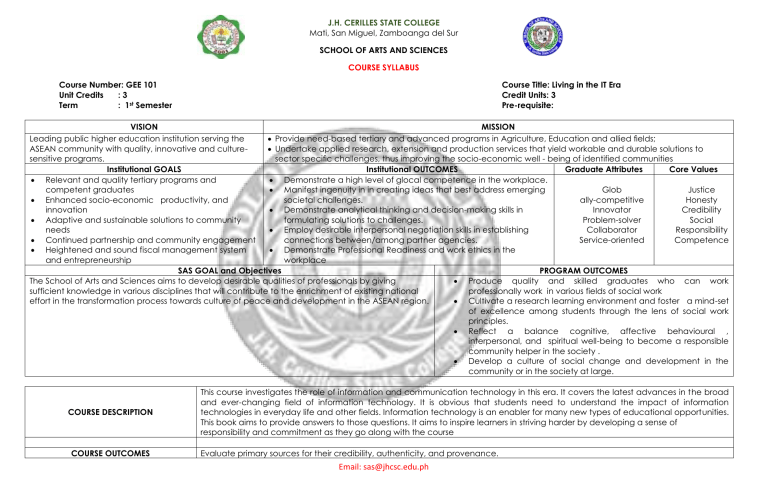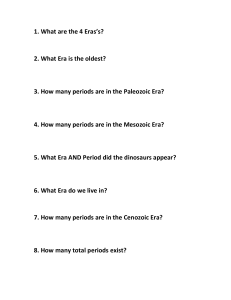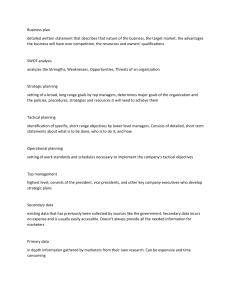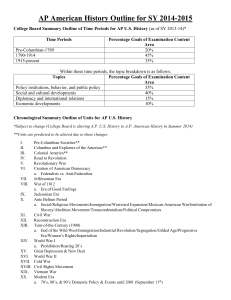
J.H. CERILLES STATE COLLEGE Mati, San Miguel, Zamboanga del Sur SCHOOL OF ARTS AND SCIENCES COURSE SYLLABUS Course Number: GEE 101 Unit Credits :3 Term : 1st Semester Course Title: Living in the IT Era Credit Units: 3 Pre-requisite: VISION MISSION Leading public higher education institution serving the Provide need-based tertiary and advanced programs in Agriculture, Education and allied fields; ASEAN community with quality, innovative and culture Undertake applied research, extension and production services that yield workable and durable solutions to sensitive programs. sector specific challenges, thus improving the socio-economic well - being of identified communities Institutional GOALS Institutional OUTCOMES Graduate Attributes Core Values Relevant and quality tertiary programs and Demonstrate a high level of glocal competence in the workplace. competent graduates Manifest ingenuity in in creating ideas that best address emerging Glob Justice Enhanced socio-economic productivity, and societal challenges. ally-competitive Honesty innovation Demonstrate analytical thinking and decision-making skills in Innovator Credibility Adaptive and sustainable solutions to community formulating solutions to challenges. Problem-solver Social needs Employ desirable interpersonal negotiation skills in establishing Collaborator Responsibility Continued partnership and community engagement connections between/among partner agencies. Service-oriented Competence Heightened and sound fiscal management system Demonstrate Professional Readiness and work ethics in the and entrepreneurship workplace SAS GOAL and Objectives PROGRAM OUTCOMES The School of Arts and Sciences aims to develop desirable qualities of professionals by giving Produce quality and skilled graduates who can work sufficient knowledge in various disciplines that will contribute to the enrichment of existing national professionally work in various fields of social work effort in the transformation process towards culture of peace and development in the ASEAN region. Cultivate a research learning environment and foster a mind-set of excellence among students through the lens of social work principles. Reflect a balance cognitive, affective behavioural , interpersonal, and spiritual well-being to become a responsible community helper in the society . Develop a culture of social change and development in the community or in the society at large. COURSE DESCRIPTION COURSE OUTCOMES This course investigates the role of information and communication technology in this era. It covers the latest advances in the broad and ever-changing field of information technology. It is obvious that students need to understand the impact of information technologies in everyday life and other fields. Information technology is an enabler for many new types of educational opportunities. This book aims to provide answers to those questions. It aims to inspire learners in striving harder by developing a sense of responsibility and commitment as they go along with the course Evaluate primary sources for their credibility, authenticity, and provenance. Email: sas@jhcsc.edu.ph 1. 2. 3. I. Identify and explain the role of information technology in everyday life, education settings, and business, as you encounter many new technologies in your everyday lives: at home, work, in the streets, in places you visit for holidays, in public spaces, through conversations and the media. Describe a wide range of products of electronic information source going from electronic periodicals to CD-ROMs, from mailing list to databases, all of them having a common feature of being used and sometime modified by a computer. Electronic information sources are becoming more and more important for the academic community. Therefore, awareness of these information resources is of paramount importance to the development in the 21st century. Identify and discuss the importance of cyber security, as now societies are becoming more dependent on computer networks, and therefore more vulnerable to cyber-crime and terrorism. Course Content Intended Learning Outcomes (ILO) At the end of this unit the students the must have: 1. Discussed how the course contributes to the attainment of BSSW Program outcomes, school goal and objectives and the broader vision and mission of the institution. 2. Recognized the knowledge the knowledge, skills, and values that will be developed at the end of the course and how will these skills help one in information and technology industry. At the end of this unit the Topic (Weekly/Lesson/Chapter) Course Description, Requirements, and Polices Time Frame Activities 1.5 hrs JHCSC Vision and Mission School Goals and Objectives Unit 1 9 hrs Outcomes-Based Assessment Lecture MIDTERM COVERAGE Laboratory Self-reading and study of handouts on the course polices; JHCSC Mission and vision; school goal and objectives; and program outcomes. N/A Lecture Email: sas@jhcsc.edu.ph Essay Writing on the questions 1. In what way does the course contribute to the attainment of the BSSW Program outcomes, school goal and objectives and vision and mission of the institutions? 2. What are some of the knowledge skills and values you will develop at the end of this course and how will these help you in your chosen career. 1. Written Activity Instructional Materials Course Syllabus of Gender and Society Handouts JHCSC Vision and Mission; School’s Goals, Objectives and Program Outcomes. 1. Concepcion, ., students the must have: 1. Drawn a visual interpretation on the role of information technology in daily life; and 2. Written a reflection by expressing ideas on the impact of information technology in daily life. 3. Explained the information technology in media industry by indicating its importance to their future career; 4. Mounted the picture of observed functions of information technology to media industry. 5. Recommended the dos and don’ts in the use of information technology to media industry At the end of this unit the students the must have: 1. Discussed the concept of information technology in education 2. Evaluated the advantages and disadvantages of IT in education 3. Created a video that will show the significance of IT in education At the end of this unit the Group Discussions Activities N/A on the visual interpretation on the impact of the information technology. Written Activityon the accomplish learning bank. Written activity on the Complete me Table Activity on Catch Me Out Written activity on Do’s and Don’ts Quizzes Unit Exam Jornales,M., Palahang,ID., Cabal, C., Taripe, K.,Omaña, M., Detalla., Liwagon,R., Lachica,O. (2020). Living in the IT ERA Module. Pp 1-22. 2. 3G E-learning LLC. (2018).Living in the IT Era. New York N/A 1. Essay on the concept of educational technology in terms of its function in times of COVID-19 pandemic. 2. Fishbone Diagram 3. Video Production 4. Quizzes and Chapter Exam 1. Concepcion, ., Jornales,M., Palahang,ID., Cabal, C., Taripe, K.,Omaña, M., Detalla., Liwagon,R., Lachica,O. (2020). Living in the IT ERA Module. Pp 31-38 2. 3G E-learning LLC. (2018).Living in the IT Era. New York N/A 1. Written activity 1. Concepcion, ., Meaning of Information Technology Role of Information Technology in Everyday Life 2. Information Technology in Media Industry 3. 4. 5. 6. 7. Unit 2 1. Concept of Information Technology in Education 2. Significance of IT in Education 3. Uses of Information Technology in Education 9 hrs Unit 3 9 hrs Lectures Group Discussion Lecture Discussion Email: sas@jhcsc.edu.ph students the must have: Information Technology in Business Strategies To Select Appropriate Hardware and Software to Meet Business Needs Telecommunications and Information Technologies Make to Business 1. Identified and explain the advantage/s of information and communications technology in business; and 2. Created a multimedia presentation and present a personal guidelines to consider in choosing a computer hardware and software in business 3. Created a Powerpoint presentation on the chosen hardware and software appropriate in business; and 4. Designed a business strategies on how to meet the needs in business. 2. 3. 4. 5. At the end of this unit the students the must have: 1. Discussed the requirements for accessing electronic information. 2. Wrote a reflection by expressing ideas on the Unit 4 Meaning of Electronic Information Resources Concept and Importance of Electronic Information Resources Management of Electronic 9 hrs Final Coverage Lecture Discussion Focus Group Discussion Email: sas@jhcsc.edu.ph N/A on advantage/s of information and communications technology in business. Activity on multimedia presentation and present a personal guidelines to consider in choosing a computer hardware and software in business Activity on Powerpoint presentation on the chosen hardware and software appropriate in business Written activity on business strategies that will meet the needs in business. Quizzes and chapter Exam 1. Written activity on the requirements on accessing the electronic information 2. Reflection paper on expressing ideas on the Jornales,M., Palahang,ID., Cabal, C., Taripe, K.,Omaña, M., Detalla., Liwagon,R., Lachica,O. (2020). Living in the IT ERA Module. Pp 42-63 2. 3G E-learning LLC. (2018).Living in the IT Era. New York 1. Concepcion, ., Jornales,M., Palahang,ID., Cabal, C., Taripe, K.,Omaña, M., Detalla., Liwagon,R., Lachica,O. (2020). Living in the IT ERA Module. Pp 42-63 impact of information technology in the industry. 3. Developed strategies processes, infrastructure, information requirements as well as making economic, legal and administrative policies of electronic information Information Resources 3. 4. At the end of this unit the students the must have: 1. Defined elements of cyber security, and determine the types of cyber security Identify security of cyberspace, vectors, occurrence and damage. 2. Explained protective and reactive approaches to security in cyberspace . 3. Illustrated how the types of cyber security protect one from the threats. Total No. of Hours Unit 5 1. Introduction to Cyber security 12 hrs 1. Lecture Discussion 2. Group Discussion N/A 1. 2. 2. The Security of Cyberspace: Vectors, Occurrence and Damage 3. 3. Protective and Reactive:Approaches to Security in Cyberspace 54 Email: sas@jhcsc.edu.ph impact of information technology in the industry. Proposal on strategies processes, infrastructure, information requirements as well as making economic, legal and administrative policies of electronic information Quizzes and Chapter Exam Written activity on the elements of cybersecurity Venn diagram on reactive and protective approached to cybersecurity. Vlogging on cybersecurity advocacy 2. 3G E-learning LLC. (2018).Living in the IT Era. New York 3. 1. Concepcion, ., Jornales,M., Palahang,ID., Cabal, C., Taripe, K.,Omaña, M., Detalla., Liwagon,R., Lachica,O. (2020). Living in the IT ERA Module. Pp 89-109 2. 3G E-learning LLC. (2018).Living in the IT Era. New York II. III. COURSE REQUIREMENTS: 1. Quizzes 2. Major Exams 3. Individual Activity Output 4. Group Activity Output 5. Others (As specified) 6. Vlogging EVALUATION CRITERIA: For Face to Face Class Quizzes/ Class Participation Assignment/Projects Major Examination Total IV. - 40% 20% 40% 100% COURSE POLICIES: A. Attendance Students are expected to face to face classes regularly. Students whose absences, even if they are excused, exceed 10% (or more than 5 days) of the total number of contact hours shall be automatically dropped from the roll. B. Examinations Students who failed to take the examination with valid reasons are allowed to take the special examination within 5 days after the examination period provided that the students pay the special examination fee. C. Requirements Requirements must be submitted on the date specified by the instructor/professor. D. Oral/Written Presentations and Other Class Activities Students are expected to participate in both oral and written presentations and other required class activities as scheduled. E. Use of Cellular Phones and Other Portable Digital Gadgets Cellular phones must be set in silent mode during online and face to face classes. Answering phone calls and text messages must be done outside the classroom or when online classes have paused/stopped. Students are allowed to use digital gadgets like laptops and tablets during online classes, and are only allowed to use these gadgets during face to face classes when the instructor/professor permits. Students may only use these gadgets with the instructor’s consent, particularly during class activities, when necessary. Furthermore, students are not allowed to use their cellular phones and other digital gadgets during examinations and quizzes. F. Students’ Behaviors during Classes During face to face classes, students are not allowed to go outside the classroom unless granted by the instructor/professor. Students who go out for more than 15 minutes shall be considered absent. Moreover, students who failed to join or leave the scheduled online classes for 15 minutes shall also be considered absent. Email: sas@jhcsc.edu.ph V. REFERENCES 3G E-learning LLC. (2018).Living in the IT Era. New York Houston Independent School District.(2019). Video Project Rubric. Retrieved https://www.houstonisd.org/site/handlers/filedownload.ashx module instanceid=117048&dataid=79783&FileName=VideoRubric.pdf Learning Sciences International. (2015).Performance Assessment. Retrieved fromwww.learningsciences.com/bookresources Robomatter Incorporation. (2016). Savanna KWL Chart Rubric. Retrieved http://www.tex22.info/rm/english/robotics2/vex/teacher/Content/Curriculum%20%20Robotics/Robo%202/Module%201/380%20Savanna%20Rubric(39).htm Date Revised: October 5,2023 Date Shown: ______________ Prepared: Reviewed by: CATHERINE D. CABAL,RPm,RGC Faculty DARLENE DARYL S. NAYO,RSW.MSW Program Chair Shown by: CATHERINE D. CABAL_ Faculty Recommending Approval: FREDERICK P. GRENGIA,PhD Dean Approved: VILMA C. GRENGIA, Ph.D. Vice President for Academic Affairs Shown to: _______________________________ Student _______________________________ Student Email: sas@jhcsc.edu.ph _________________________________ Student


